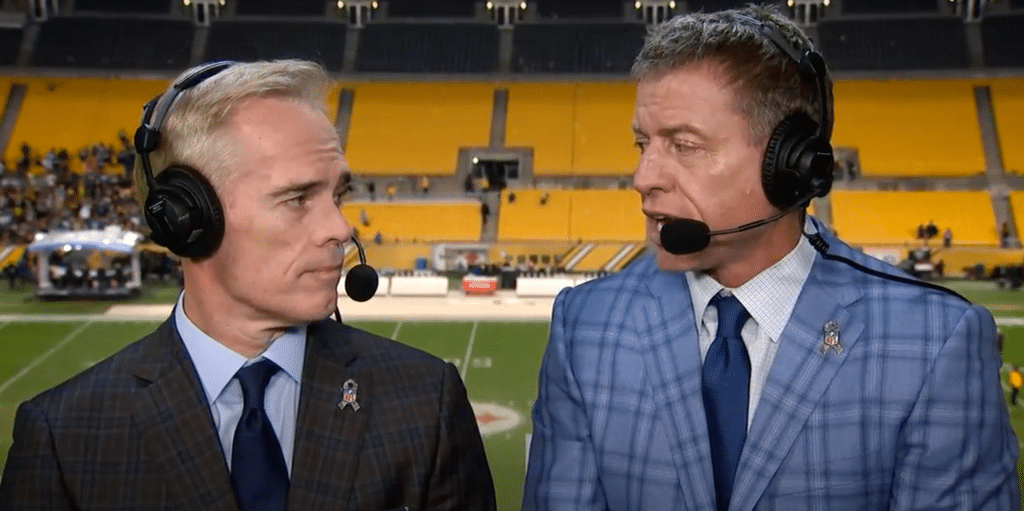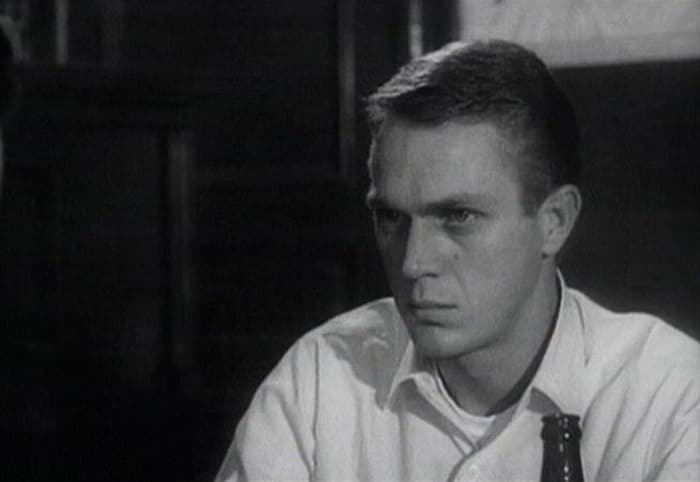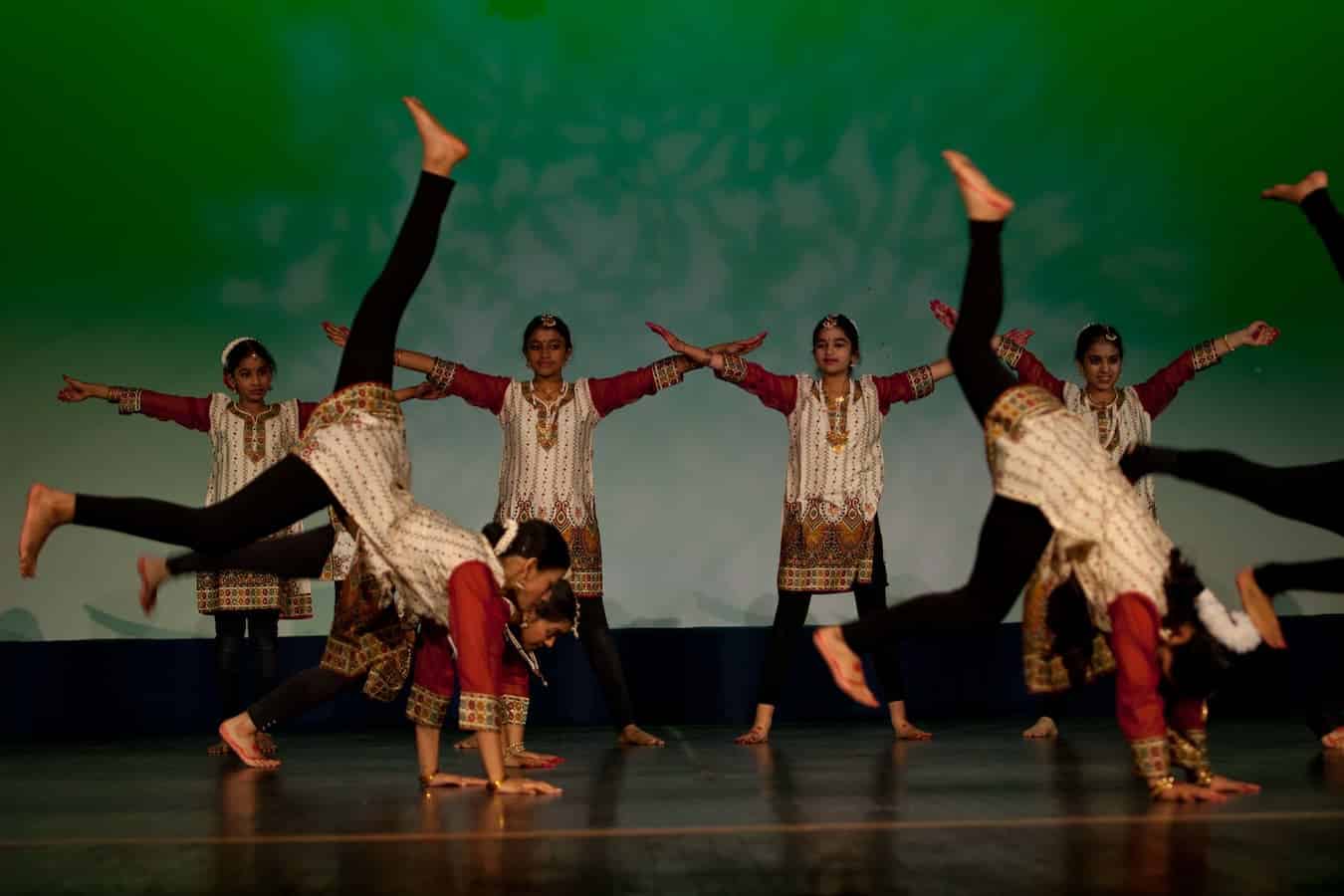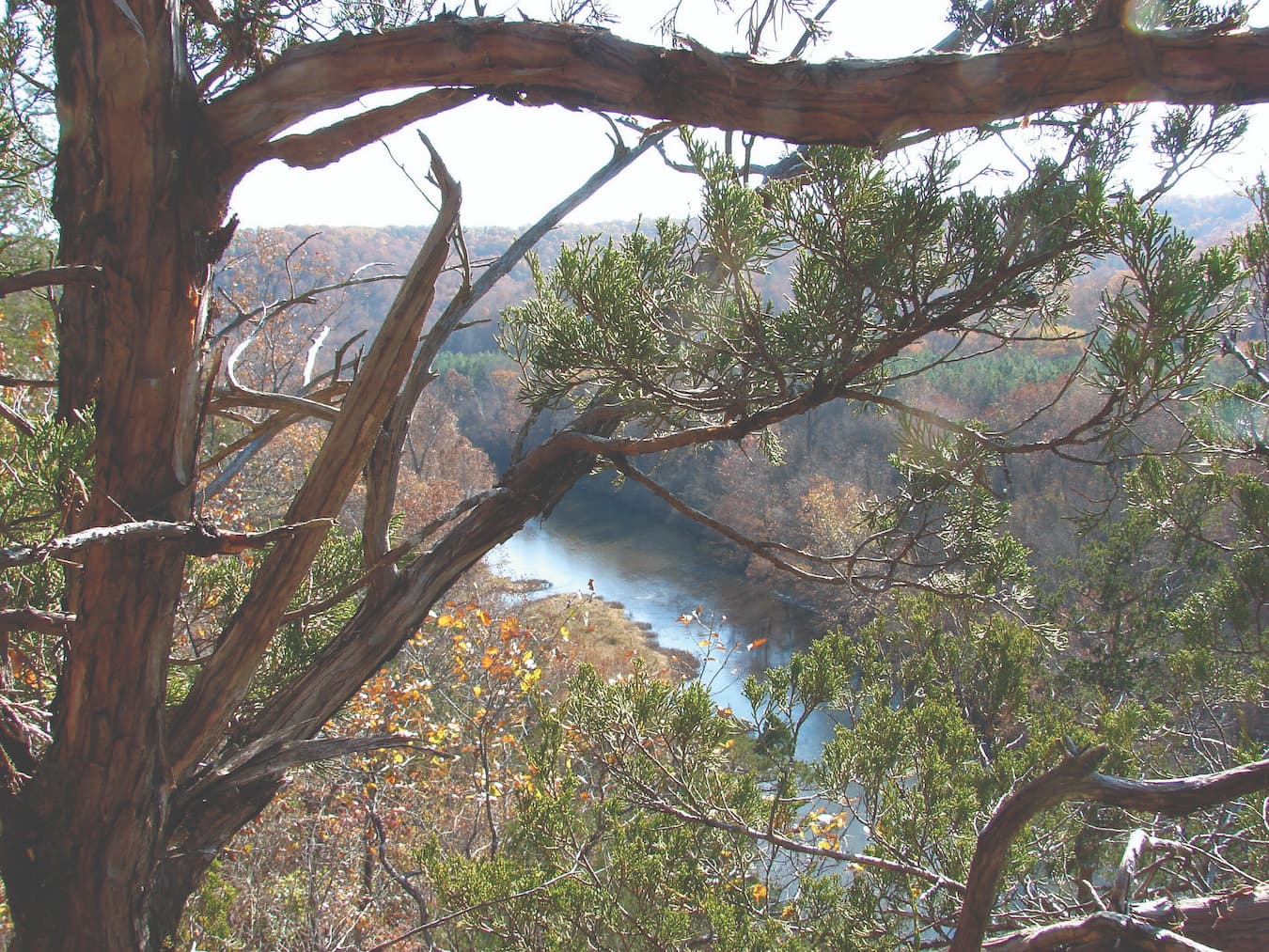When the clouds hang low over St. Louis, the air on the east side of Forest Park fills with a strong, distinct aroma. In about a square mile, there are four coffee roasters, and when Ronnoco, Thomas, Kaldi, and Northwest all begin turning Coffea Arabica beans over high heat at the same time, they blanket the neighborhood with the scents of toasted bread, a wood fire, and a jungle after a light rain: the smell of roasting coffee.
Missourians love their coff ee now as much as they did hundreds of years ago when the French first brought coff ee to the shores of the Mississippi River. Indie co ffee shops, boutique roasters, national brands, and regional roasters are pleasing customers all over the state.
“St. Louis is the original coff ee town of America,” Dan Pabst says. Dan is Ronnoco Handcrafted Coff ee’s specialty coff ee consultant and one of Missouri’s few licensed Q graders, a certification he earned through rigorous testing with the Coff ee Quality Institute. He moved to Missouri from Virginia to work for Ronnoco a few years ago.
When Ronnoco began roasting coff ee more than 100 years ago, steamboats regularly delivered South American coff ee beans to St. Louis, and the coff ee fanned out to the rest of the country from here.
“By 1900, St. Louis was known throughout the world as a coff ee capital,” says Katie Moon, with the Missouri History Museum.
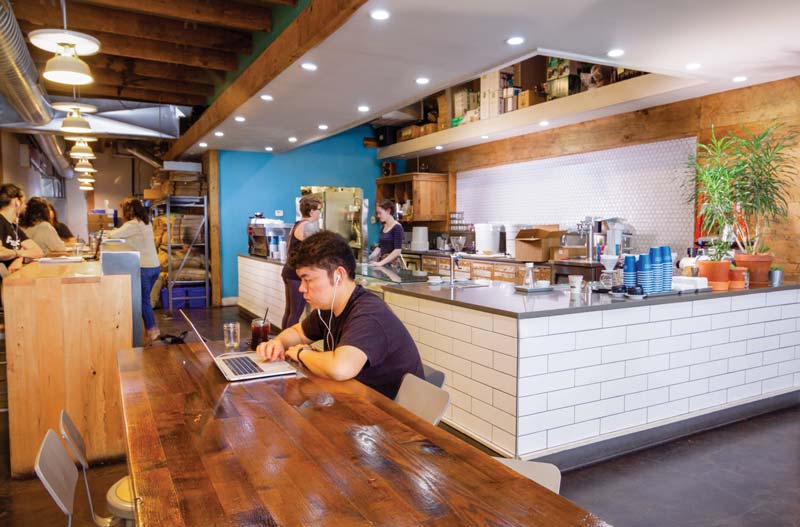
Some of St. Louis’s historic coff ee brands were Schotten Coff ee, Old Judge Coff ee, Allen-Rethemeyer Co ffee, Hanley & Kinsella Coff ee and Spice Co., C.F. Blanke Tea & Co ffee Company, and Safari. A few of those brands were ahead of their time: Schotten employed the first female executive of a coffee company, and Hanley limited its workers to just eight hours of labor a day. Many others, though, eschewed such clean business practices: several were caught adding fillers such as chicory or sawdust to their co ffee.
These early 20th-century businesses used interesting marketing strategies. Blanke used representations of the legendary German demon Mephistopheles to sell its Faust brand of ground coff ee and advertised the convenience of an early instant co ffee, Blanke’s “Quick Cup” Fluid Coff ee, in 1900. Another, Dana Brown’s Safari Co ffee, marketed itself through the owner’s outlandish personality as he toured Africa hunting wild game. Many of them created unique ways of packaging their coff ee, such as a metal box meant to be reused as a cake tin or a dollhouse.
“By the 1930s,” Katie says, “using preroasted, preground, prepackaged coffee had become the norm for households and businesses in St. Louis.” This type of coffee is what experts now call first-wave coffee.
The history of coffee in the United States is divided into three waves. Coffee’s second wave hit in the late 1960s, when Alfred Peet turned the industry on its head. A native of Holland, Peet came to the United States after World War II and couldn’t stomach American-style coffee. He brought the European coffee culture to his Berkeley, California, shop, roasting high-quality beans in small batches and serving espresso to Americans who were ready for this new way of enjoying coffee.
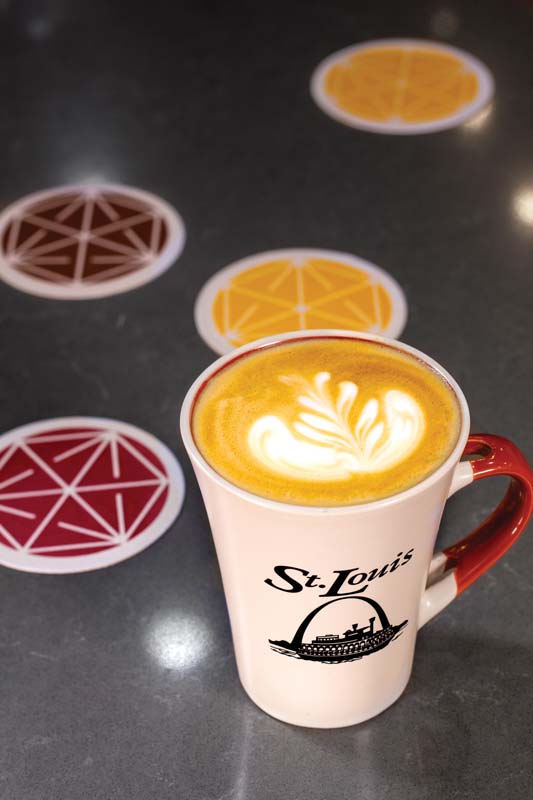
This second wave brought about Starbucks in 1971 and other high-end coffeehouses, Dan says. “The original Starbucks in Seattle was also a big deal in the second wave and is how we know what lattes and cappuccinos are.”
Long before the rest of America queued up for trendy java, St. Louis’s Montileone’s Café Espresso in Gaslight Square acquired an espresso machine in the early ’60s. In 1987, Kirkwood baker Ken Rosenthal opened Saint Louis Bread Company on Manchester Road; it became Panera in 1997. Now a national chain of more than 2,000 bakerycafes, it was—and still is—a coffee force in America.
But now we’re in the third wave.
“Third-wave coffee is a movement hyper-focused on the details of each specific coffee to produce a product that is at its full potential of flavor and quality,” says Danielle Parrie, manager at Blip Coffee Roasters in Kansas City, one of the city’s popular coffee houses. “It is a focus on growing practices and fair business deals. It’s roasting beans and scientifically changing variables to create roast profiles for each specific coffee.”
The arrival of third-wave coffee has led to a coffee boom in Missouri. St. Louis currently has about 16 coffee roasters, which is getting close to the 20 roasters that were in business in 1910 during the city’s coffee heyday. Residents gush about sipping at Sump, where skulls adorn each black bag of roasted coffee and there is no cream-and-sugar station. Stay-at-home parents gather at Hartford Coffee near Tower Grove Park because of the shop’s huge play area for children. Hipsters crowd into Cherokee Street’s Mudhouse for coffee and brunch on the weekends. Even coffee trucks are a part of the scene, with Rise Co ffee’s truck and the debut this year of Surge Coff ee Truck, which will serve Park Avenue’s sustainably roasted co ffee.
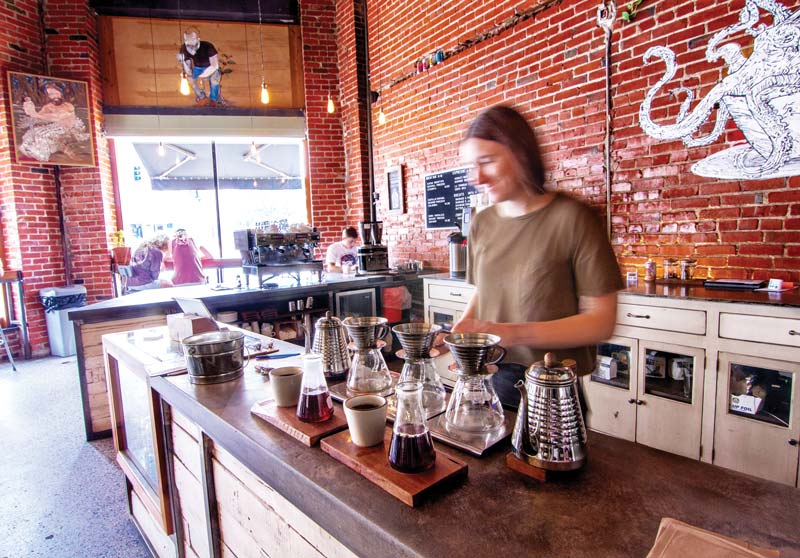
This revival extends beyond America’s original coffee capital, to Blip’s home in Kansas City and to smaller Missouri cities and towns where welcoming co ffee shops serve locally roasted coff ee in community gathering spaces. In Kansas City, people gather at Messenger Coff ee, a spot that blogger Mary Bloch says is “part cafe, part roaster, part bakery [with] fabulous co ffee, bread, and pastries.”
Kansas City is also home to Oddly Correct, which Epicurious.com named one of America’s Top 25 Co ffee Shops, calling Kansas City “the best US co ffee scene you’ve never heard of.” Kansas City is home to seven roasters. There are four in the Springfield area, and three in Columbia. You’ll find roasters in smaller Missouri cities, too, such as Je fferson City, Grandview, and Ironton, among others.
In the middle of the state in Warsaw, Cosmic Cafe has been recognized as having great coff ee. Owner Shannon Noland decided to carry Missouri’s own Kaldi’s Coff ee after touring its facility in 2006. “They o ffered me a black cup of coff ee, and I said I needed cream and sugar,” she says. “They said, ‘We don’t do that here.’” Shannon was skeptical, but the product won her over. “I drank three cups black; it was so good. I said if it’s that good black, it must be the best product.”
Blip’s Danielle Parrie says the brewing method also matters in the third wave. “It’s finding brew methods to extract flavors and emphasize and highlight characteristics and unique qualities of di fferent beans,” she says. New brew methods are also fun, “specifically with cold-brewing coffee, such as the Kyoto system.” The system is “just a fancylooking glass utilizing gravity to make coff ee,” Danielle says. There’s also the Nitro cold brew, she adds, “a classic toddy run through a tap system and made creamy with nitrogen.”
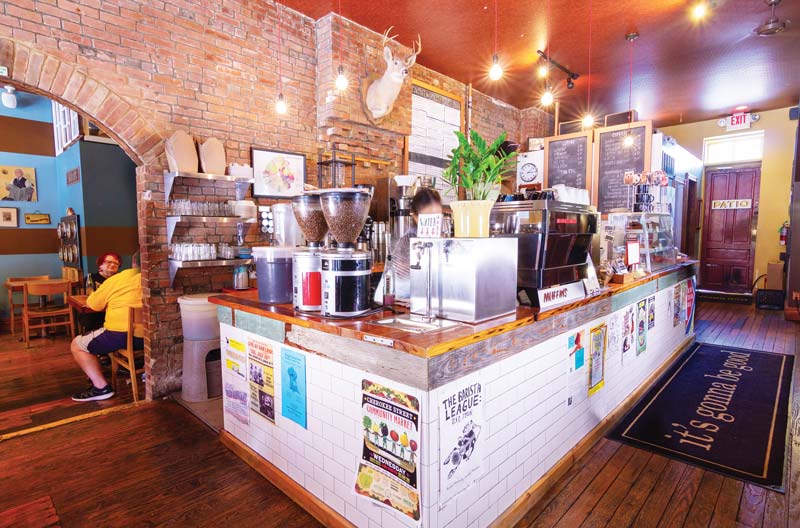
But Danielle believes coff ee makers should carefully choose the right brew method for their product and not let flashy techniques detract from the co ffee. “Consumers want the latest and greatest and have all the cool-looking concoctions they see on social media,” she says. “The wow factor is definitely something that people are willing to pay for. But I think the hype that they buy into can sort of distract from the actual product and factors, such as flavor.”
Danielle compares the popularity of third-wave coffee with that of craft beer. “Coff ee is the next craft niche developing and similar to how we’ve seen a huge boom in microbreweries,” she says. “The market for coff ee is enormous, far greater than that of alcohol, so I can’t imagine this boom dissipating.”
Ronnoco’s Dan Pabst says the upsurge of co ffee shops in Missouri is happening partly because people want quality coff ee and partly because people need a community gathering place. “There is a philosophy that all humans in society need three places: work, home, and number three,” he says. A good local co ffee shop provides four things: “Delicious co ffee, delicious food, and free internet,” Dan says, plus that community gathering place.
Third-wave coff ee costs more than a dollar: this brew is a luxury. “Every industry will have its snobs, but there is a co ffee for everybody,” Dan says.
Related Posts
Joe Buck is Born: April 25, 1969
Joe Buck, who grew up in St. Louis and spent many years calling Cardinals games, was born on this date.
The Great St. Louis Bank Robbery Takes Place: April 24, 1953
A lethal heist gone wrong took place on this date in 1953.
Experience India Through Music and Dance
The American Natya Festival, now in its fifteenth year, is a three-day celebration of Indian artistic tradition. Performers from around the United States and India will dazzle audiences with spirited song and dance and elaborate costumes.
Beauty on the Current
The richly diverse Current River State Park features almost two miles of beautiful river frontage, offering ample opportunity for swimming, floating, and fishing as well as hiking, backcountry camping, and interpretive programming.

